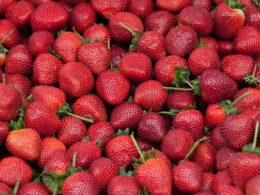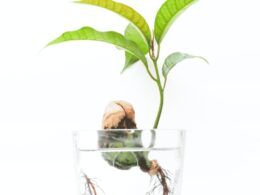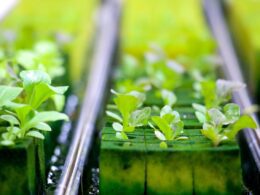Are you interested in starting your own hydroponic garden but don’t know where to begin? Hydroponic gardening is a method of growing plants without soil, using nutrient-rich water instead. It’s a great option for those who want to grow their own fresh produce but don’t have access to outdoor space or favorable soil conditions.
When it comes to selecting plants for your hydroponic garden, there are a few factors to consider. Some plants are better suited for this type of growing than others, and you’ll want to choose ones that are easy to maintain and produce a high yield.
With the right selection of plants and proper care, you can enjoy a bountiful harvest of fresh vegetables and herbs from your own hydroponic garden. So, let’s dive in and explore what plants grow best in hydroponic gardens and how to set one up for success.
Understanding Hydroponic Gardening
Discovering how to cultivate a thriving soil-free system is the focus of this section. Hydroponic gardening is a method of growing plants without soil. This technique uses water and a nutrient solution to provide the plants with all the necessary elements for healthy growth.
Hydroponic gardening has many benefits. This system allows for more control over the plant’s environment, which leads to faster growth, higher yields, and healthier plants. There are several types of hydroponic systems, including deep water culture, drip irrigation, and nutrient film technique.
Deep water culture involves suspending the roots of the plants in a nutrient-rich solution. Drip irrigation systems use a pump to deliver water and nutrients to the plants. Nutrient film technique involves a shallow stream of nutrient solution that flows over the roots of the plants. Each system has its advantages and disadvantages, but all provide a soil-free option for growing plants.
Hydroponic gardening is an excellent way to grow plants, especially if you have limited space or want to grow fresh produce year-round. With the proper setup and maintenance, this technique can produce healthy, delicious produce.
Understanding the benefits of hydroponic gardening and the different types of systems available can help you choose the best one for your needs. So, get started on your hydroponic gardening journey and watch your plants thrive!
Choosing the Right Plants
To truly succeed in your hydroponic setup, you need to carefully consider which types of crops will thrive in this unique environment.
The first thing to keep in mind is climate considerations. Hydroponic gardens are often indoor setups, which means you have complete control over the temperature, humidity, and lighting. This gives you the flexibility to grow plants that aren’t native to your area or that require specific growing conditions.
It’s also important to consider the nutrient requirements of your chosen plants. Unlike traditional soil-based gardening, hydroponic systems rely on nutrient-rich water solutions to feed the plants.
Some crops, such as lettuce and herbs, have relatively simple nutrient requirements and are therefore easier to grow in a hydroponic setup. Other crops, such as fruiting plants like tomatoes or peppers, require a more complex nutrient mix to thrive.
Overall, the key to choosing the right plants for your hydroponic garden is to do your research. Consider the climate of your growing area and the nutrient requirements of your desired crops. With the right planning and attention to detail, you can create a thriving hydroponic garden that produces healthy, delicious crops for years to come.
Setting Up Your Hydroponic Garden
Now it’s time for you to set up your own hydroponic system and start reaping the benefits of fresh, nutrient-rich produce right at home.
First, you need to choose the right hydroponic system option. There are various options available, such as deep water culture, nutrient film technique, drip irrigation, and aeroponics. Each system has its own advantages and disadvantages, so you need to research and choose the one that suits your needs and preferences.
Once you have chosen the right hydroponic system, the next step is to prepare the nutrient solution. This solution is the key to ensuring that your plants grow healthy and strong. You can either buy pre-made nutrient solutions or make your own using essential nutrients like nitrogen, phosphorus, and potassium.
It’s important to regularly monitor the pH and nutrient levels to ensure that your plants are receiving the right amount of nutrients.
After setting up the hydroponic system and preparing the nutrient solution, it’s time to start planting your desired crops. You can grow a variety of plants in a hydroponic garden, including leafy greens, herbs, tomatoes, and strawberries.
Make sure to follow the recommended planting instructions and monitor the growth of your plants regularly. With the right hydroponic system and nutrient solution, you can enjoy fresh, healthy produce all year round.
Maintaining Your Hydroponic Garden
To maintain your hydroponic garden, you need to keep an eye on the pH level of your nutrient solution regularly. This is essential for the healthy growth of your plants.
You also need to be vigilant about pest and disease management. Additionally, it’s crucial to harvest and prune your plants regularly to ensure maximum yield.
Monitoring pH levels
Checking pH levels regularly helps maintain a healthy and thriving hydroponic system. pH level importance can’t be overstated, as it affects the ability of plants to absorb nutrients. If the pH level is too high or too low, plants won’t absorb the necessary nutrients, which can lead to stunted growth or even death.
Therefore, it’s crucial to monitor pH levels regularly to ensure optimal plant growth. To monitor pH levels, there are various pH testing methods available. One simple method is to use pH test strips, which can be easily purchased from any garden center. Alternatively, digital pH meters provide more accurate readings, and some even have automatic calibration features.
It’s essential to follow the manufacturer’s instructions for proper calibration and use of pH testing equipment. Monitoring pH levels may seem like a tedious task, but it’s a crucial step in maintaining a healthy hydroponic garden. By doing so, you can ensure that your plants receive the necessary nutrients they need to grow and thrive.
Pest and Disease Management
You need to be vigilant in managing pests and diseases to ensure the health and longevity of your crop. Preventing infestations is key, as once pests or diseases take hold, they can quickly spread and decimate your plants.
Keep a close eye on your plants and regularly inspect them for signs of pests such as aphids, whiteflies, or spider mites. If you notice any signs of infestation, take action immediately to prevent the problem from spreading.
One effective way to manage pests and diseases in your hydroponic garden is by using natural remedies. There are many organic and non-toxic options available that can be just as effective as chemical pesticides. For example, introducing beneficial insects such as ladybugs or lacewings can help control aphids and other pests. Additionally, neem oil, garlic oil, and essential oils such as peppermint or rosemary can be used as a natural insecticide.
By being proactive in managing pests and diseases and using natural remedies, you can ensure the health and productivity of your hydroponic garden.
Harvesting and Pruning
Harvesting and pruning are essential for maintaining the quality and yield of your crops, and it’s important to regularly assess and tend to your plants to ensure their success.
Maximizing yield means harvesting at the right time, removing dead leaves and branches, and ensuring that the plant has enough space to grow. Make sure to use proper equipment when pruning, such as sharp scissors or shears, to avoid damaging the plant.
When harvesting, it’s important to avoid damaging the roots and stem of the plant. Cut the stem at a 45-degree angle and avoid pulling the plant out of its container.
Make sure to also remove any fruits or vegetables that are damaged or diseased, as they can attract pests and diseases to your hydroponic garden.
By regularly harvesting and pruning your plants, you’ll not only maximize your yield, but also promote healthy growth and prevent future problems.
Tips for Success
To really thrive in a hydroponic setup, it’s all about finding the right balance of nutrients, water, and light. One important consideration is maintaining a proper pH balance. This can be achieved by regularly testing and adjusting the pH levels of your nutrient solutions.
Most plants prefer a pH range between 5.5 and 6.5, but it’s important to research the specific needs of the plants you’re growing.
Another tip for hydroponic success is to use high-quality nutrient solutions. It’s important to choose a solution that is specifically designed for hydroponic gardening, as these solutions are formulated to provide all of the necessary nutrients in the correct proportions.
Be sure to follow the manufacturer’s instructions for mixing and applying the solution, as overfeeding can be just as harmful as underfeeding.
Finally, don’t underestimate the importance of light. Plants require different amounts of light depending on their species, so it’s important to research the specific needs of the plants you’re growing.
In general, most plants require between 12 and 16 hours of light per day. LED grow lights are a popular choice for hydroponic setups because they are energy-efficient and can be customized to provide the specific spectrum of light that each plant needs.
With the right balance of nutrients, water, and light, your hydroponic garden will be sure to thrive.
Frequently Asked Questions
What are the most common mistakes made by beginners in hydroponic gardening?
As a beginner in hydroponic gardening, it’s common to make some mistakes that can lead to nutrient imbalances and pH issues.
One of the most common mistakes is overfeeding your plants, which can cause nutrient burn and other problems.
Another common mistake is not checking the pH levels of your nutrient solution regularly, which can lead to nutrient lockout.
Troubleshooting these issues can be difficult, but it’s important to pay close attention to your plants and make adjustments as needed.
By avoiding these common mistakes and staying on top of your nutrient and pH levels, you can create a healthy and thriving hydroponic garden.
Can hydroponic gardening be done outdoors, or does it require a controlled indoor environment?
When it comes to hydroponic gardening, you may be wondering if it’s possible to do it outdoors. The answer is yes, but there are some important factors to consider.
One of the biggest pros of outdoor hydroponic gardening is that you have access to natural sunlight, which can be a huge advantage for plant growth. However, outdoor gardening also comes with its own set of cons, such as the potential for weather-related issues and pests.
Choosing the right hydroponic system for outdoor use is also crucial, as some systems may not be able to withstand the elements.
Overall, outdoor hydroponic gardening can be a great option, but it’s important to weigh the pros and cons before diving in.
Are there any plants that should not be grown in a hydroponic garden?
When it comes to hydroponic gardening, there are certain plants that should be avoided. These include plants with extensive root systems, such as trees and shrubs, as well as those that are prone to disease or pests.
However, many plants thrive in a hydroponic environment, and there are numerous benefits to this type of gardening. Hydroponic gardening allows for precise control over the growing conditions, resulting in higher yields and faster growth rates. Additionally, hydroponic gardening uses less water and fertilizer than traditional gardening methods, making it an eco-friendly option.
So, while there are some plants to avoid, there are plenty of options for a successful hydroponic garden.
How often should the nutrient solution be changed in a hydroponic garden?
To maintain optimal plant growth in your hydroponic garden, it’s important to regularly change the nutrient solution. The frequency of this change will depend on factors such as the size of your system, the types of plants you’re growing, and the quality of your nutrients.
Testing and adjusting pH levels is also crucial, as it ensures that your plants are able to absorb the necessary nutrients. For the safest and most effective results, consider using organic nutrients. These offer a range of benefits, including improved plant growth and reduced risk of chemical exposure.
By taking these steps, you can ensure that your hydroponic garden thrives and produces healthy, nutritious plants.
Is it necessary to use artificial lighting in a hydroponic garden, or can natural light suffice?
Using natural light in a hydroponic garden can be tempting, but artificial lighting is necessary for optimal plant growth. The impact of light spectrum on plant growth cannot be ignored, and artificial lights allow for precise control over the spectrum and intensity of light.
While natural light can provide some benefits, it is often inconsistent and can limit the types of plants that can be grown. With artificial lighting, you have the freedom to grow a wider variety of plants and can create the perfect conditions for each one.
So, while natural light may seem like a cost-effective option, investing in artificial lighting will ultimately yield better results in your hydroponic garden.
Conclusion
So, you now know what hydroponic gardening is and which plants grow best in this type of gardening. Remember to choose the right plants, set up your garden properly, and maintain it regularly to ensure success.
Don’t forget to monitor your plants’ growth and adjust your system as needed. With the right care and attention, you’ll be able to enjoy fresh and healthy produce all year round.
Happy gardening!









